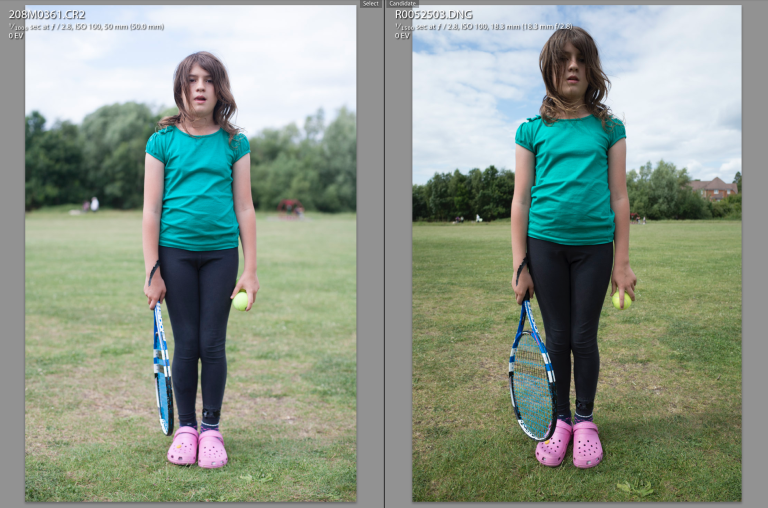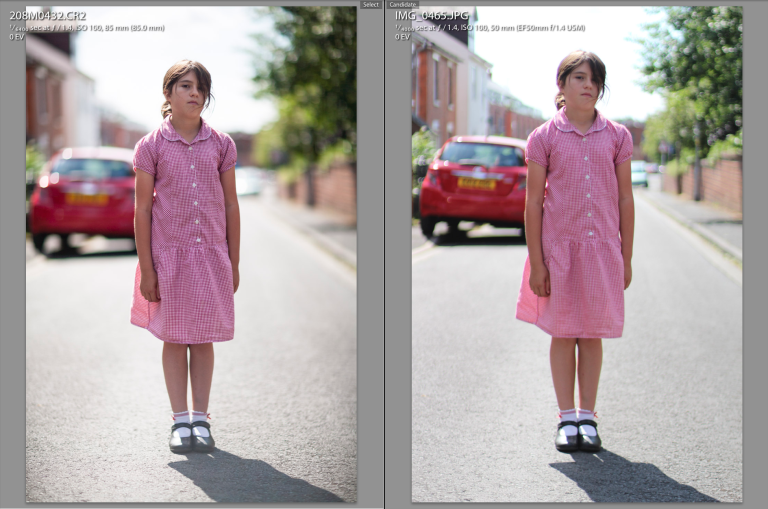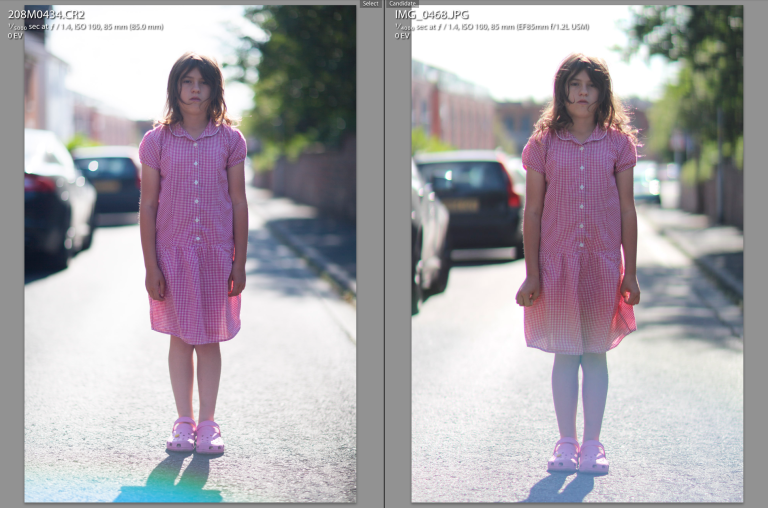I like photographing people. I also like to carry a small camera around.
Photos of people generally look better when you separate the subject from the background using a narrow depth of field.
So do I lose a narrow depth of field when I use my Ricoh GR compared to my 1DS? Or more interestingly, a crop sensor DSLR compared to my 1DS?
None of the explanations on depth of field and sensor size I have read on the web quite made sense to me, and some seemed plain wrong, so I thought I’d do some comparisons…
1DS 50mm vs GR 28mm
Let’s try taking the same picture with a Canon EOS 1DS with a 50mm 1.4 and a Ricoh GR (28mm equivalent).
To even things up I’ve used the same aperture (2.8) for both.

Left: Canon EOS 1DS, 50mm 1.4 at f2.8 Right: Ricoh GR, 28mm equivalent at f2.8
The wider angle (28mm equivalent – but it is really an 18mm) means you have to be much closer to the subject. (She’s looking a bit elongated.)
Most of all though, look at the depth of field. Thanks to the narrower angle of view, there’s less background in the 50mm; it looks closer and it is much more blurred.
The Ricoh’s wide angle captures loads of scenery in the distance; it looks further away and is sharper.
So, when it comes to separating the subject from the background, the DS has it, and that’s thanks to the longer focal length.
1DS 85mm vs 100D 50mm (80mm equivalent)
But does sensor size have anything to do with it?
If I use the 50mm on a cropped sensor it will be like using an 80mm lens on a full sensor (50 x 1.6 = 80). So let’s compare the 50mm 1.4 on a 100D with a 85mm 1.2 on the 1DS.
We’re using the same aperture (1.4) and the pics were taken at the same distance from the subject.

Left: Canon EOS 1DS Mark II, 85mm 1.2 at f1.4 Right: Canon EOS 100D, 50mm 1.4 at f1.4
There’s much better separation from the 85mm on the 1DS.
That’s the same focal length (or is it… see below), the same aperture, just a different sensor. So sensor size does make a difference.
Why?
Because I haven’t actually changed the focal length of the 50mm by mounting it on the 100D… I’ve just cropped it.
And shorter focal lengths have wider depths of field. So the 85mm has a narrower depth of field because it’s an 85mm.
The bigger sensor lets me make full use of it as an 85mm.
1DS 85mm vs 100D 85mm
Finally let’s look at the same lens on a full and a crop sensor camera.

Left: Canon EOS 1DS Mark II, 85mm 1.2 at f1.4 Right: Canon EOS 100D, 85mm 1.2 at f1.4
So I should have used the lens hood… and I’m not sure Florence is completely thrilled about standing in the middle of the road while I try not to drop two cameras and two lenses.
Anyway, I’ve had to come far, far away with the 100D to get the same framing, so the background appears compressed and less blurred.
And that’s because I’m stood in a different place, so I’m focussing on a subject that’s further away, and so getting a wider depth of field.
So even with the same actual focal length, the smaller sensor forces me further away to get the same shot and so can’t match the big sensor’s depth of field.
Conclusion
So, aperture aside, for max depth of field get close to the subject with a long focal length. Which is more easily done with a large sensor camera.
Or as my http://www.35mmc.com friend Hamish puts it:
“It’s a simple as this really; the larger the sensor the closer you have to get to fill the frame with a given focal length. The closer you get the narrower the depth of field.”
So, yes I am missing out carrying anything other than my 1DS around. Damn.
See also
Looking for the basics on aperture and depth of field? Try this:https://www.photographytalk.com/beginner-photography-tips/7356-a-beginner-s-guide-to-aperture-and-depth-of-field